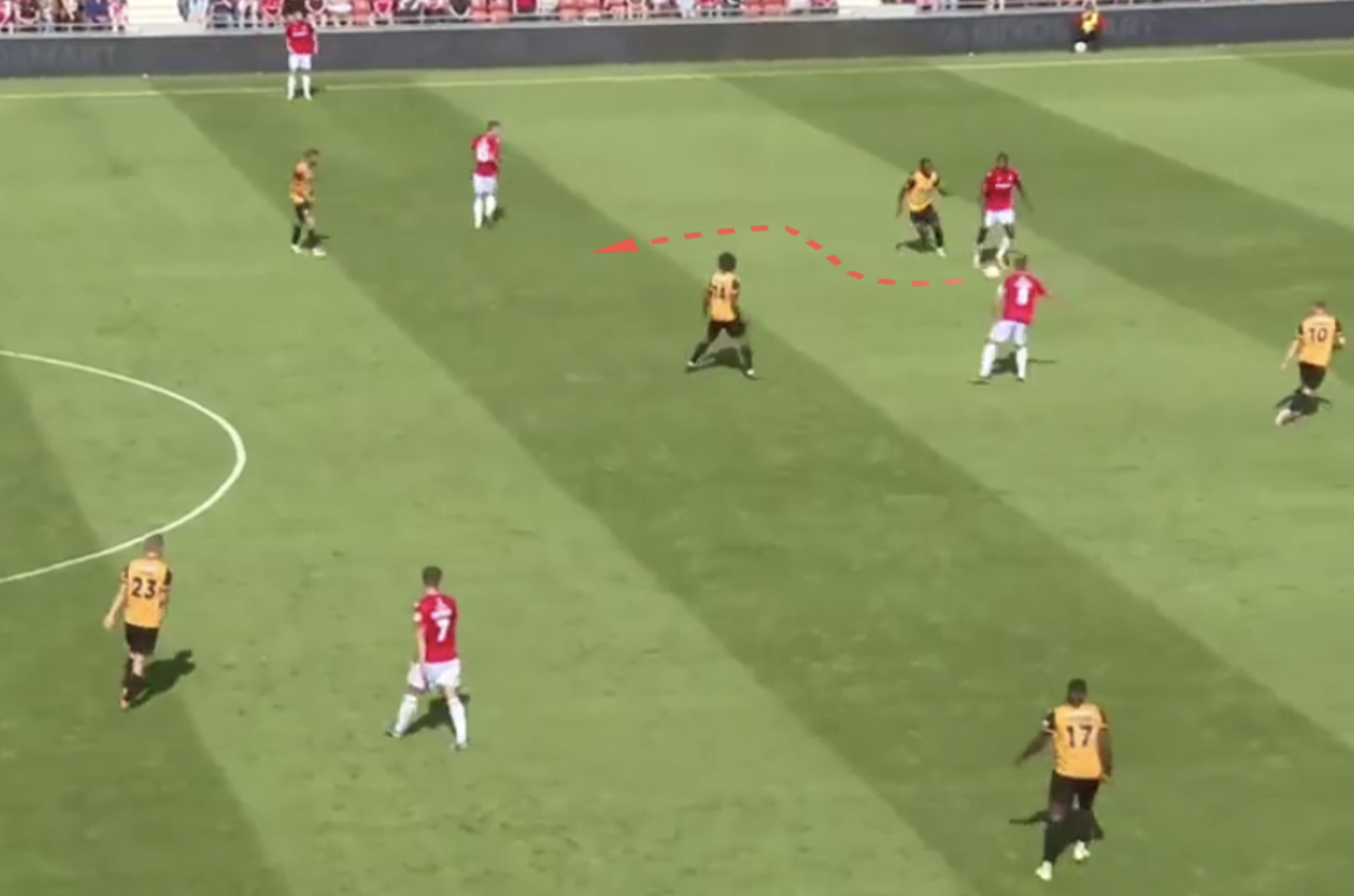IN FOCUS: Aaron Hayden
Who better than our August Player of the Month to start off a new ‘In Focus’ series?
Aaron Hayden was, along with an unlucky Max Cleworth (who was excellent), a class apart in the early weeks and has shown no hangover from the injury that ruled him out of the back-end of last season.
‘Aaron is immense,’ Parkinson said after the televised win at Woking.
‘He was immense for us last season, too. We missed him when he went out injured as he gets goals for us.’
Asked then if, after he scored two crucial goals in the 3-2 win, he is the most dominant player in both boxes in the division, Parkinson was having a hard time coming up with a worthy opponent.
‘He’s almost unmarketable the way he leaps,’ Parkinson added.
Wrexham have been spoiled in the centre back position in the last decade alone - think Nat Knight-Percival; think Mark Creighton; think Manny Smith; think Jamal Fyfield; think Shaun Pearson. There have been loads.
But in Hayden, Wrexham fans can see a player that is destined to thrive at a much higher level.
Here, RobRyanRed takes a closer look at Hayden, a player that started out as a striker as a youngster in Sunday League, and why he is one of the most important pieces to Parkinson’s puzzle.
OPEN PLAY
It should be taken as a sign of respect that opposition game-plans appear to factor in that they will, where possible, look to target Wrexham’s left side, rather than their right.
That is, in large part, down to Hayden and his dominance both in the air but also on the floor. He is comfortable driving the ball out from the back three and it was his ball down the line towards Ollie Palmer that drew the second yellow card in the Gateshead match, reducing them to 10 men.
Hayden’s lateral movements have improved having settled into this back three with Ben Tozer and Cleworth and there is now an unspoken awareness, on most occasions, of when he is able to press aggressively up the pitch and when he need to drop as the recovering man.
One of the areas of Hayden’s game that he is continuing to develop is his body positioning when out of possession.
In this example in the Gateshead match his original body position, side on and facing the attacker on the run isn’t too bad.
It was a poor header under no real pressure to Owen Bailey (pictured with the ball) but it is only when Hayden looks to be aggressive and intercept the through ball, opening his body out to be square on to Bailey and therefore leaving Adam Campbell too much space to run into.
Tozer cannot recover and Campbell really should score, forcing a strong save out of Mark Howard.
Hayden has shown he more often than not takes the upper hand in one v one situations and here is another useful example from that same Gateshead game.
A long diagonal switch from right to left picks out Kenton Richardson and Hayden initially looks to have been caught out in behind with a 7 metre gap between him and Richardson. Hayden’s first step is good and his recovery pace forced a first time cross from Gateshead - danger averted.
Gateshead liked their left flank that night and in the pictured example you can see Dan Ward who has got in behind Anthony Forde and in the pocket of space between Hayden and the wing-back.
While his decision-making with the Campbell chance later in the game raised questions, in this instance he gets it spot on. Hayden finds himself eight metres away from Ward, who has decent body position driving into the top left corner of the area.
In three steps the distance is closed to 5 metres and Hayden is able to take some of the sting out the shot at goal, preventing a near-certain equaliser for 2-2 had it been a slower centre back.
Hayden has spoken previously about having a ballet teacher come round to his house as an academy player at Chelsea and Wolves and there is definitely a lightness on his feet and to his burst movements that show the principles have stuck with him.
His on-ball decision-making is an interesting facet of his game. Hayden’s displays are predicated, firstly, on winning aerial battles in both boxes, seconded by keeping discipline in the shape and the clean sheet.
But, like Cleworth on the other side, he has been brought up to be comfortable with the ball at his feet and in the Maidstone game, a match where Wrexham dominated the ball and faced little threat in behind, he showed his composure in driving out from the defence.
In this example (below) you can see that James Jones has elected not to target Forde at right wing-back and has instead gone short to Hayden.
Maidstone initially do well to cut off Hayden’s shift to the wing-back and it appears his only avenue is back to Howard. But instead he drops the shoulder, more akin to a midfielder or striker on the last line of defence, and spots a gap between two Maidstone bodies.
From there he uses his strength and in turn opens up four passing lanes: Jones, Forde, Mullin and Palmer. Centre backs comfortable with the ball at their feet are invaluable in drawing more attention to open pockets of space either centrally for midfielders or for wide players.
Typically centre backs are afforded room on the ball as they are considered no real threat but Hayden has shown his passing range both on the floor and over the top and in the Maidstone game he proved he commands respect when in possession as much as he does out of it.
IN THE AIR
Easily one of Hayden’s biggest attributes. In a one-v-one aerial duel he is, as Parkinson put it at Woking, almost ‘unmarkable’.
But his ability goes beyond just out muscling and out jumping his rivals. Hayden is clever in that he often likes to pick up deeper positions - he can alternate between occupying the front or back post - towards the far post and with so much respect given to his aerial prowess, he can open up huge spaces for late-running midfielders or the other defenders to occupy.
Below is a free-kick on Paddock side in the win over Gateshead. Hayden is seen in front of Ben Tozer, before peeling off further. From there a chain of events is set in play where his run towards the near post drags multiple markers out of position and allows Tozer to, largely, head for the back post quadrant under minimal pressure, leading to the opening goal from a deflection.
While his first goal at Woking didn’t come from a set-piece, the construct of it is distinctly similar to what led to Tozer’s goal against Gateshead. Again Hayden elects to peel off towards the back post and this time he has successfully managed to get separation goal-side of his marker.
You can both the No 3 and No 4 have switched off and the ball in from Mullin is meat and drink for someone of Hayden’s heading ability. One of the most striking things about Hayden’s ability in the air is the power and direction he generates.
His body position against Woking initially suggested that the inswinging ball would be headed back across goal in a bid to wrong foot the goalkeeper. Instead, he’s showed, from 14m away, the deft touch to guide it into the corner. Unsaveable. 1-0.
Goals from set-pieces are a key component of what Parkinson has built at Wrexham and it is why the Tozer throw-in proved so effective throughout last season.
Even when he himself is not on the end of things, Hayden garners so much attention that, in the win over Maidstone (pictured below) you can see his shirt being pulled with multiple players trying to prevent him from gaining elevation to connect.
So much focus is placed onto Hayden and Palmer that it goes on to be an own goal - and a third in the half for Wrexham. Much of that move came down to the chaos Hayden creates at set-pieces and while he has shown he is not infallible defensively - Gateshead’s opening goal saw him leave too big a quadrant of space at the front post to make up through a crowd - it is an area where Wrexham know they have one of the most dominant players in the box at either end.











